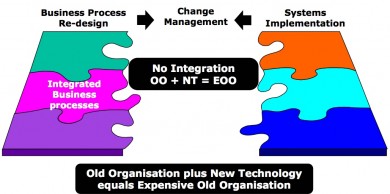It makes no sense to adapt to an imaginary future that is not yet in place. It’s causing unnecessary resistance.
In the 1990’s management guru Michael Hammer became famous with BPR (Business Process Reengineering). In 2005 he released a video on succeeding with SAP underscoring why so many implementations fail.
There was also some math involved in his approach to SAP implementation success. The formula he used to show the importance of communication, sponsorship and accompaniment of resistance to change was the following:
OO + NT = EOO
(Old Organization + New Technology = Expensive Old Organization)
What sets the successful implementations apart from the unsuccessful ones is the perseverance to transform the organization along with the new technology. This means adapting the ways of working, the roles to make that new ways of working possible, and setting up the communication for those new roles. The formula then becomes:
NO + NT = Implementation Success
(New Organization + New Technology = Implementation Success)
Let’s have a closer look at what it takes to get to ‘NO’ (New Organization). Two things are important here:
1. Begin with the end in mind
This insight is quite straightforward; we are not implementing ERP programs because of its features like multicurrency, the ability to define sales organizations, reporting, etc. We are doing so because we want to gain benefits that are essential for the survival of the organization.
Another way of putting it is that we need to focus on installation instead of realization. Installation is defined as putting the intended change in place. Installation occurs when the change (e.g., hardware, software, training, new organizational structure) is deployed into the workplace. Realization means achieving the expected value of your change.
Technology is an enabler on that path, not a goal. When we fail to paint a clear picture of the destination in terms of what this means to the organization, we run the risk of ending up with an expensive toy that everybody regrets. That’s why we need to pursue benefits.
2. There is no straight path
Fair enough you may say, so the only thing we need to do is to change the organization first and then put the new technology in place. As logical as this may sound, it just doesn’t work that way. This is a wall I have been banging my head against for the past decade.
There is a dip we need to go through in every implementation, because a new organization only makes sense in the light of the technology that is installed. And I know what you are thinking right now… As an organizational change practitioner I am supposed to proclaim that we need to change the organization first, and then move on with the installation.
You know what? I found out that this is not true! It’s a waste of time and money. The way it really works is by going through the following sequence:
1. OO + OT = status quo
(Old Organization + Old Technology = Status Quo)
2. OO + NT = EOO
(Old Organization + New Technology = Expensive Old Organization)
3. NO + NT = implementation success
(New Organization + New Technology = Implementation Success)
This means that EOO (Expensive Old Organization) is phase you need to go through. It’s an ugly mirror to look in and it scares a lot of organizations who then chicken out and decide to stop there. We should realize that we are in the middle of a dip and success can only be achieved when we push through.
In fact, this is where the real work for change practitioners begins, because we can only adapt to a new reality when it is in place. The point is that it makes no sense to adapt to an imaginary future that is not yet in place. It’s causing unnecessary resistance.


